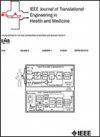ICT-Net: An Integrated Convolution and Transformer-Based Network for Complex Liver and Liver Tumor Region Segmentation
IF 4.4
3区 医学
Q2 ENGINEERING, BIOMEDICAL
IEEE Journal of Translational Engineering in Health and Medicine-Jtehm
Pub Date : 2025-07-07
DOI:10.1109/JTEHM.2025.3586470
引用次数: 0
Abstract
Background: Automatic segmentation of liver regions as well as liver lesions such as hepatocellular carcinoma (HCC) from computed tomography (CT) images is critical for accurate diagnosis and therapy planning. With the advent of deep learning techniques such as transformers, computer-aided diagnostic tools (CADs) have the potential to increase the accuracy of liver tumor diagnosis, progression, and treatment planning. However, two major challenges remain: 1) existing models struggle to extract robust spatial features for accurate liver and liver lesion segmentation, and 2) publicly available liver datasets with HCC annotations are limited. Methods: We first present a new liver dataset acquired from Chongqing University Cancer Hospital (CCH-LHCC-CT) with HCC annotations. Second, we developed a novel deep learning architecture (ICT-Net), which is constructed based on a pretrained transformer encoder in conjunction with an advanced feature upscaling and enhanced convolution-transformer decoder formation. Results: We performed liver and liver tumor segmentation on the CCH-LHCC-CT and three public CT liver datasets. The proposed ICT-Net architecture achieves superior accuracy (higher ACC/DSC/IoU, lower HD95) across all datasets. Conclusions: We construct a novel deep-learning architecture that produces robust information for liver and liver tumor segmentation. The statistical and visual results demonstrate that the proposed ICT-Net outperforms other existing approaches investigated in this study in terms of ACC, DSC, and IoU. Clinical Translation Statement: ICT-Net enhances surgical planning accuracy through precise tumor margin delineation and improves therapy response assessment reliability, which holds meaningful promise to support more precise and effective clinical therapeutic strategies for patients with HCC.ICT-Net:基于卷积和变压器的复杂肝脏和肝脏肿瘤区域分割集成网络
背景:从计算机断层扫描(CT)图像中自动分割肝脏区域和肝脏病变,如肝细胞癌(HCC),对于准确诊断和治疗计划至关重要。随着变压器等深度学习技术的出现,计算机辅助诊断工具(cad)有可能提高肝脏肿瘤诊断、进展和治疗计划的准确性。然而,仍然存在两个主要挑战:1)现有模型难以提取稳健的空间特征来准确分割肝脏和肝脏病变;2)公开可用的带有HCC注释的肝脏数据集有限。方法:我们首先展示了从重庆大学肿瘤医院(CCH-LHCC-CT)获得的具有HCC注释的新肝脏数据集。其次,我们开发了一种新的深度学习架构(ICT-Net),该架构基于预训练的变压器编码器,并结合先进的特征升级和增强的卷积-变压器解码器形成。结果:我们在CCH-LHCC-CT和三个公共CT肝脏数据集上进行了肝脏和肝脏肿瘤分割。提议的ICT-Net架构在所有数据集上实现了卓越的精度(更高的ACC/DSC/IoU,更低的HD95)。结论:我们构建了一种新的深度学习架构,可以为肝脏和肝脏肿瘤分割提供鲁棒信息。统计和可视化结果表明,拟议的ICT-Net在ACC、DSC和IoU方面优于本研究中调查的其他现有方法。临床翻译声明:ICT-Net通过精确的肿瘤边缘描绘提高了手术计划的准确性,提高了治疗反应评估的可靠性,为HCC患者提供更精确有效的临床治疗策略提供了有意义的希望。
本文章由计算机程序翻译,如有差异,请以英文原文为准。
求助全文
约1分钟内获得全文
求助全文
来源期刊

IEEE Journal of Translational Engineering in Health and Medicine-Jtehm
Engineering-Biomedical Engineering
CiteScore
7.40
自引率
2.90%
发文量
65
审稿时长
27 weeks
期刊介绍:
The IEEE Journal of Translational Engineering in Health and Medicine is an open access product that bridges the engineering and clinical worlds, focusing on detailed descriptions of advanced technical solutions to a clinical need along with clinical results and healthcare relevance. The journal provides a platform for state-of-the-art technology directions in the interdisciplinary field of biomedical engineering, embracing engineering, life sciences and medicine. A unique aspect of the journal is its ability to foster a collaboration between physicians and engineers for presenting broad and compelling real world technological and engineering solutions that can be implemented in the interest of improving quality of patient care and treatment outcomes, thereby reducing costs and improving efficiency. The journal provides an active forum for clinical research and relevant state-of the-art technology for members of all the IEEE societies that have an interest in biomedical engineering as well as reaching out directly to physicians and the medical community through the American Medical Association (AMA) and other clinical societies. The scope of the journal includes, but is not limited, to topics on: Medical devices, healthcare delivery systems, global healthcare initiatives, and ICT based services; Technological relevance to healthcare cost reduction; Technology affecting healthcare management, decision-making, and policy; Advanced technical work that is applied to solving specific clinical needs.
 求助内容:
求助内容: 应助结果提醒方式:
应助结果提醒方式:


